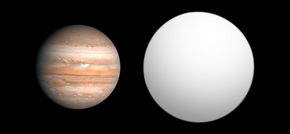 Size comparison of WASP-19b with Jupiter. | |
| Discovery[1] | |
|---|---|
| Discovered by | Hebb et al. (SuperWASP) |
| Discovery date | December 10, 2009 |
| Transit | |
| Designations | |
| Banksia[2] | |
| Orbital characteristics | |
| 0.01655 ± 0.00013 AU (2,476,000 ± 19,000 km) | |
| Eccentricity | 0.0046+0.0044 −0.0028[3] |
| 0.79 ± 0.0000003 d (18.9600000 ± 7.2×10−6 h; 68,256.000 ± 0.026 s)[1] | |
| Inclination | 79.4±0.4[3] |
| Star | WASP-19 |
| Physical characteristics | |
| 1.386±0.032[3] RJ | |
| Mass | 1.168±0.023[3] MJ |
Mean density | 0.68 g/cm3[citation needed] |
| Albedo | <0.26 [4] 0.16±0.04[5] |
| Temperature | 2350+168 −314[6] 2240±40[5] |
WASP-19b, formally named Banksia,[2] is an exoplanet, notable for possessing one of the shortest orbital periods of any known planetary body: 0.79 days or approximately 18.932 hours. It has a mass close to that of Jupiter (1.15 Jupiter masses), but by comparison has a much larger radius (1.31 times that of Jupiter, or 0.13 Solar radii); making it nearly the size of a low-mass star.[1] It orbits the star WASP-19 in the Vela constellation. At the time of discovery it was the shortest period hot Jupiter discovered as planets with shorter orbital periods had a rocky, or metallic composition.
A study in 2012, utilizing the Rossiter–McLaughlin effect, determined the planetary orbit is well aligned with the equatorial plane of the star, misalignment equal to -15±11°.[7]
In 2013, secondary eclipse and orbital phases were barely observed from the data gathered with ASTEP telescope, making it the first detection of such kind through ground-based observations. This was possible due to the large size of the planet and its small semi-major axis.[4]
In 2019 the planet was observed with TESS and the eclipse of the planet was measured. The broad variations caused by the changing aspect of the heated face of the planet were measured. The study deduced that the dayside has a temperature of 2240 ± 40 K (1967 ± 40 °C) and that the planet reflects 16 ± 4 percent of the light that falls on it. The last value is relatively high compared to other planets.[8][5]
Despite the short orbital period, orbital decay of WASP-19b was not detected as of 2019.[9]
- ^ a b c Cite error: The named reference
Hebb2010was invoked but never defined (see the help page). - ^ a b Cite error: The named reference
NEW2022was invoked but never defined (see the help page). - ^ a b c d "Notes for planet WASP-19b". Extrasolar Planets Encyclopaedia. Retrieved 2009-12-10.
- ^ a b Abe, L.; Gonçalves, I.; Agabi, A.; Alapini, A.; Guillot, T.; Mékarnia, D.; Rivet, J.-P.; Schmider, F.-X.; Crouzet, N.; Fortney, J.; Pont, F.; Barbieri, M.; Daban, J.-B.; Fanteï-Caujolle, Y.; Gouvret, C.; Bresson, Y.; Roussel, A.; Bonhomme, S.; Robini, A.; Dugué, M.; Bondoux, E.; Péron, S.; Petit, P.-Y.; Szulágyi, J.; Fruth, T.; Erikson, A.; Rauer, H.; Fressin, F.; Valbousquet, F.; et al. (2013). "The secondary eclipses of WASP-19b as seen by the ASTEP 400 telescope from Antarctica". Astronomy & Astrophysics. 553: A49. arXiv:1303.0973. Bibcode:2013A&A...553A..49A. doi:10.1051/0004-6361/201220351. S2CID 119227468.
- ^ a b c Wong, Ian; Benneke, Björn; Shporer, Avi; Fetherolf, Tara; Kane, Stephen R.; Ricker, George R.; Vanderspek, Roland; Seager, Sara; Winn, Joshua N.; Collins, Karen A.; Mireles, Ismael; Morris, Robert; Tenenbaum, Peter; Ting, Eric B.; Rinehart, Stephen; Villaseñor, Jesus Noel (2020). "TESS Phase Curve of the Hot Jupiter WASP-19b". The Astronomical Journal. 159 (3): 104. arXiv:1912.06773. Bibcode:2020AJ....159..104W. doi:10.3847/1538-3881/ab6d6e. S2CID 209376464.
- ^ Cite error: The named reference
Sedaghati2017was invoked but never defined (see the help page). - ^ Albrecht, Simon; Winn, Joshua N.; Johnson, John A.; Howard, Andrew W.; Marcy, Geoffrey W.; Butler, R. Paul; Arriagada, Pamela; Crane, Jeffrey D.; Shectman, Stephen A.; Thompson, Ian B.; Hirano, Teruyuki; Bakos, Gaspar; Hartman, Joel D. (2012), "Obliquities of Hot Jupiter Host Stars: Evidence for Tidal Interactions and Primordial Misalignments", The Astrophysical Journal, 757 (1): 18, arXiv:1206.6105, Bibcode:2012ApJ...757...18A, doi:10.1088/0004-637X/757/1/18, S2CID 17174530
- ^ waspplanets (2019-12-19). "TESS phase curve of WASP-19b". WASP Planets. Retrieved 2020-01-01.
- ^ Petrucci, R.; Jofré, E.; Gómez Maqueo Chew, Y.; Hinse, T. C.; Mašek, M.; Tan, T-G; Gómez, M. (2019), "Discarding orbital decay in WASP-19b after one decade of transit observations★†", Monthly Notices of the Royal Astronomical Society, arXiv:1910.11930, doi:10.1093/mnras/stz3034